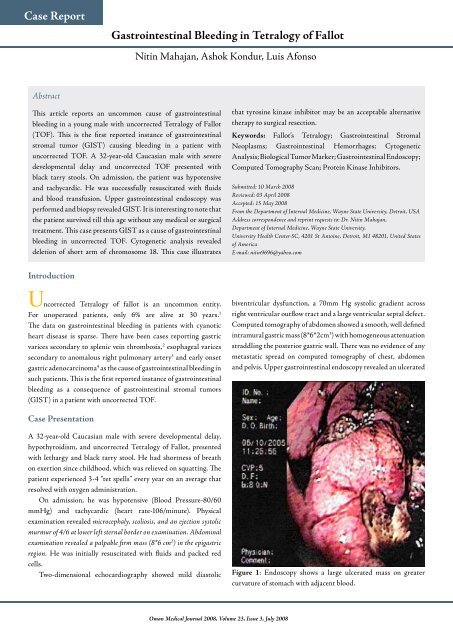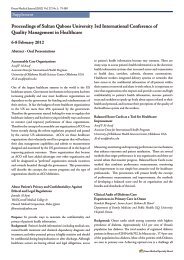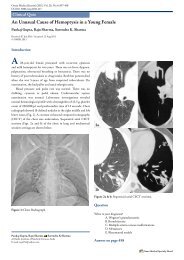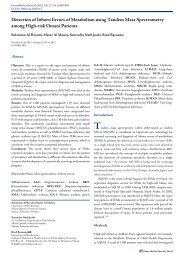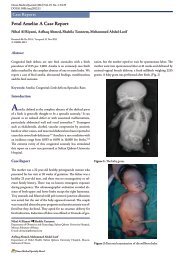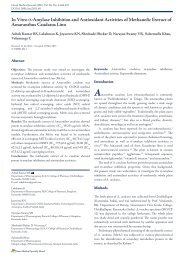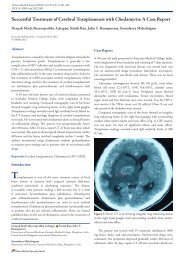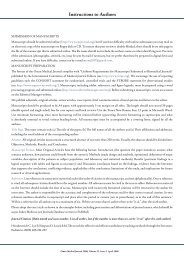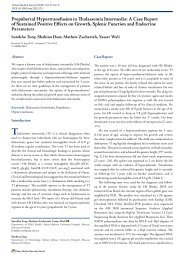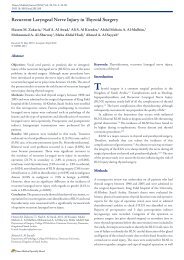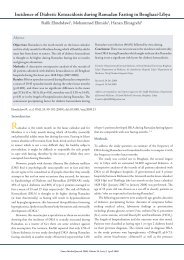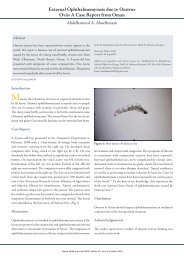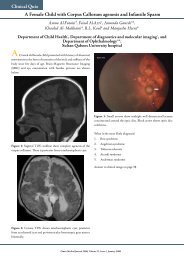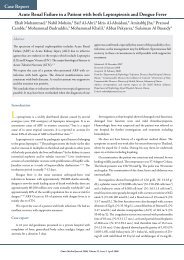Gastrointestinal Bleeding in tetralogy of fallot Case report - OMJ
Gastrointestinal Bleeding in tetralogy of fallot Case report - OMJ
Gastrointestinal Bleeding in tetralogy of fallot Case report - OMJ
You also want an ePaper? Increase the reach of your titles
YUMPU automatically turns print PDFs into web optimized ePapers that Google loves.
<strong>Case</strong> Report<br />
<strong>Gastro<strong>in</strong>test<strong>in</strong>al</strong> <strong>Bleed<strong>in</strong>g</strong> <strong>in</strong> Tetralogy <strong>of</strong> Fallot<br />
Nit<strong>in</strong> Mahajan, Ashok Kondur, Luis Afonso<br />
Abstract<br />
This article <strong>report</strong>s an uncommon cause <strong>of</strong> gastro<strong>in</strong>test<strong>in</strong>al<br />
bleed<strong>in</strong>g <strong>in</strong> a young male with uncorrected Tetralogy <strong>of</strong> Fallot<br />
(TOF). This is the first <strong>report</strong>ed <strong>in</strong>stance <strong>of</strong> gastro<strong>in</strong>test<strong>in</strong>al<br />
stromal tumor (GIST) caus<strong>in</strong>g bleed<strong>in</strong>g <strong>in</strong> a patient with<br />
uncorrected TOF. A 32-year-old Caucasian male with severe<br />
developmental delay and uncorrected TOF presented with<br />
black tarry stools. On admission, the patient was hypotensive<br />
and tachycardic. He was successfully resuscitated with fluids<br />
and blood transfusion. Upper gastro<strong>in</strong>test<strong>in</strong>al endoscopy was<br />
performed and biopsy revealed GIST. It is <strong>in</strong>terest<strong>in</strong>g to note that<br />
the patient survived till this age without any medical or surgical<br />
treatment. This case presents GIST as a cause <strong>of</strong> gastro<strong>in</strong>test<strong>in</strong>al<br />
bleed<strong>in</strong>g <strong>in</strong> uncorrected TOF. Cytogenetic analysis revealed<br />
deletion <strong>of</strong> short arm <strong>of</strong> chromosome 18. This case illustrates<br />
that tyros<strong>in</strong>e k<strong>in</strong>ase <strong>in</strong>hibitor may be an acceptable alternative<br />
therapy to surgical resection.<br />
Keywords: Fallot’s Tetralogy; <strong>Gastro<strong>in</strong>test<strong>in</strong>al</strong> Stromal<br />
Neoplasms; <strong>Gastro<strong>in</strong>test<strong>in</strong>al</strong> Hemorrhages; Cytogenetic<br />
Analysis; Biological Tumor Marker; <strong>Gastro<strong>in</strong>test<strong>in</strong>al</strong> Endoscopy;<br />
Computed Tomography Scan; Prote<strong>in</strong> K<strong>in</strong>ase Inhibitors.<br />
Submitted: 10 March 2008<br />
Reviewed: 03 April 2008<br />
Accepted: 15 May 2008<br />
From the Department <strong>of</strong> Internal Medic<strong>in</strong>e, Wayne State University, Detroit, USA<br />
Address correspondence and repr<strong>in</strong>t requests to: Dr. Nit<strong>in</strong> Mahajan,<br />
Department <strong>of</strong> Internal Medic<strong>in</strong>e, Wayne State University,<br />
University Health Center-5C, 4201 St Anto<strong>in</strong>e, Detroit, MI 48201, United States<br />
<strong>of</strong> America<br />
E-mail: nit<strong>in</strong>9696@yahoo.com<br />
Introduction<br />
Uncorrected Tetralogy <strong>of</strong> <strong>fallot</strong> is an uncommon entity.<br />
For unoperated patients, only 6% are alive at 30 years. 1<br />
The data on gastro<strong>in</strong>test<strong>in</strong>al bleed<strong>in</strong>g <strong>in</strong> patients with cyanotic<br />
heart disease is sparse. There have been cases <strong>report</strong><strong>in</strong>g gastric<br />
varices secondary to splenic ve<strong>in</strong> thrombosis, 2 esophageal varices<br />
secondary to anomalous right pulmonary artery 3 and early onset<br />
gastric adenocarc<strong>in</strong>oma 4 as the cause <strong>of</strong> gastro<strong>in</strong>test<strong>in</strong>al bleed<strong>in</strong>g <strong>in</strong><br />
such patients. This is the first <strong>report</strong>ed <strong>in</strong>stance <strong>of</strong> gastro<strong>in</strong>test<strong>in</strong>al<br />
bleed<strong>in</strong>g as a consequence <strong>of</strong> gastro<strong>in</strong>test<strong>in</strong>al stromal tumors<br />
(GIST) <strong>in</strong> a patient with uncorrected TOF.<br />
biventricular dysfunction, a 70mm Hg systolic gradient across<br />
right ventricular outflow tract and a large ventricular septal defect.<br />
Computed tomography <strong>of</strong> abdomen showed a smooth, well def<strong>in</strong>ed<br />
<strong>in</strong>tramural gastric mass (8*6*2cm 3 ) with homogeneous attenuation<br />
straddl<strong>in</strong>g the posterior gastric wall. There was no evidence <strong>of</strong> any<br />
metastatic spread on computed tomography <strong>of</strong> chest, abdomen<br />
and pelvis. Upper gastro<strong>in</strong>test<strong>in</strong>al endoscopy revealed an ulcerated<br />
<strong>Case</strong> Presentation<br />
A 32-year-old Caucasian male with severe developmental delay,<br />
hypothyroidism, and uncorrected Tetralogy <strong>of</strong> Fallot, presented<br />
with lethargy and black tarry stool. He had shortness <strong>of</strong> breath<br />
on exertion s<strong>in</strong>ce childhood, which was relieved on squatt<strong>in</strong>g. The<br />
patient experienced 3-4 “tet spells” every year on an average that<br />
resolved with oxygen adm<strong>in</strong>istration.<br />
On admission, he was hypotensive (Blood Pressure-80/60<br />
mmHg) and tachycardic (heart rate-106/m<strong>in</strong>ute). Physical<br />
exam<strong>in</strong>ation revealed microcephaly, scoliosis, and an ejection systolic<br />
murmur <strong>of</strong> 4/6 at lower left sternal border on exam<strong>in</strong>ation. Abdom<strong>in</strong>al<br />
exam<strong>in</strong>ation revealed a palpable firm mass (8*6 cm 2 ) <strong>in</strong> the epigastric<br />
region. He was <strong>in</strong>itially resuscitated with fluids and packed red<br />
cells.<br />
Two-dimensional echocardiography showed mild diastolic<br />
Figure 1: Endoscopy shows a large ulcerated mass on greater<br />
curvature <strong>of</strong> stomach with adjacent blood.<br />
Oman Medical Journal 2008, Volume 23, Issue 3, July 2008
<strong>Bleed<strong>in</strong>g</strong> <strong>in</strong> Tetralogy <strong>of</strong> Fallot ... Mahajan et al.<br />
gastric mass (Figure 1). The gastro<strong>in</strong>test<strong>in</strong>al bleed<strong>in</strong>g was self<br />
limited, and did not require any endoscopic hemostasis. The<br />
gastric mass biopsy was consistent with gastro<strong>in</strong>test<strong>in</strong>al stromal<br />
tumor (Figure 2). On immunosta<strong>in</strong><strong>in</strong>g, the tumor was positive for<br />
CD-117 (C-kit) and CD-34, and negative for the smooth muscle<br />
markers act<strong>in</strong> and desm<strong>in</strong> and the neuronal marker, S-100 prote<strong>in</strong>.<br />
Cytogenetic analysis revealed deletion <strong>of</strong> short arm <strong>of</strong> chromosome<br />
18. The patient’s family refused surgical resection and he was<br />
treated with imat<strong>in</strong>ib mesylate (tyros<strong>in</strong>e k<strong>in</strong>ase <strong>in</strong>hibitor).<br />
mean age <strong>of</strong> presentation is <strong>in</strong> the 6 th decade. It usually presents<br />
as a solitary mass. The cellular morphology <strong>of</strong> GIST is variable<br />
and <strong>in</strong>cludes sp<strong>in</strong>dle-shaped and epithelioid cells. The cells may<br />
show juxtanuclear cytoplasmic vacuoles and nuclear palisad<strong>in</strong>g.<br />
Diagnostic markers <strong>in</strong>clude CD 34, desm<strong>in</strong>, viment<strong>in</strong>, smooth<br />
muscle act<strong>in</strong> and CD 117. The management <strong>of</strong> these patients<br />
<strong>in</strong>volves risk assessment for recurrence or metastasis. Tumors that<br />
are larger than 5cm, are lobulated, enhance heterogeneously, have<br />
mesenteric fat <strong>in</strong>filtration, ulceration, regional lymphadenopathy<br />
or an exophytic growth pattern or have >5 mitotic rate per 50<br />
high power field are associated with a significant risk <strong>of</strong> metastasis<br />
or recurrence. 5,6 The mitotic <strong>in</strong>dex is the most useful histologic<br />
criterion for malignancy and prognosis. GISTs frequently<br />
metastasize to the liver, and rarely to regional lymph nodes. All<br />
GISTs ≥2 cm <strong>in</strong> size are managed with surgical resection.<br />
This patient was managed conservatively with imat<strong>in</strong>ib<br />
mesylate after the histologic confirmation <strong>of</strong> GIST. No recurrent<br />
gastro<strong>in</strong>test<strong>in</strong>al bleeds have been <strong>report</strong>ed on 2 years follow-up.<br />
Conclusion<br />
Figure 2: Shows epithelioid cells hav<strong>in</strong>g round central nuclei<br />
with<strong>in</strong> eos<strong>in</strong>ophilic or clear cytoplasm.<br />
Tetralogy <strong>of</strong> Fallot is the most common cyanotic congenital<br />
heart disease <strong>in</strong> adults and children after the age <strong>of</strong> 4 years. For<br />
unoperated patients, 11% are alive at 20 years, 6% at 30 years, and<br />
3% at 40 years. 1<br />
The data on gastro<strong>in</strong>test<strong>in</strong>al bleed<strong>in</strong>g <strong>in</strong> patients with cyanotic<br />
heart disease is sparse. These patients are prone to bleed<strong>in</strong>g as a<br />
consequence <strong>of</strong> erythrocytosis, shortened platelet survival and<br />
clott<strong>in</strong>g factor deficiencies. Prior published case-<strong>report</strong>s have<br />
<strong>report</strong>ed gastric varices secondary to splenic ve<strong>in</strong> thrombosis<br />
(result<strong>in</strong>g from <strong>in</strong>creased blood viscosity due to polycythemia), 2<br />
esophageal varices secondary to anomalous right pulmonary<br />
artery 3 and early onset gastric adenocarc<strong>in</strong>oma 4 as the cause <strong>of</strong><br />
gastro<strong>in</strong>test<strong>in</strong>al bleed<strong>in</strong>g <strong>in</strong> patients with TOF. This is the first<br />
<strong>report</strong>ed <strong>in</strong>stance <strong>of</strong> gastro<strong>in</strong>test<strong>in</strong>al bleed<strong>in</strong>g as a consequence<br />
<strong>of</strong> gastro<strong>in</strong>test<strong>in</strong>al stromal tumors (GIST) <strong>in</strong> a patient with<br />
uncorrected TOF.<br />
GISTs are rare. They constitute only 1 percent <strong>of</strong> primary<br />
gastro<strong>in</strong>test<strong>in</strong>al cancers and only a few microscopic tumors grow<br />
<strong>in</strong>to masses with malignant potential. GIST is the most common<br />
subset <strong>of</strong> mesenchymal tumors specific for the alimentary tract.<br />
The <strong>in</strong>terstitial cells <strong>of</strong> Cajal or more primitive progenitor<br />
mesenchymal cells are suggested as their cells <strong>of</strong> orig<strong>in</strong>. The<br />
It is also <strong>in</strong>terest<strong>in</strong>g to note that the patient survived till this age<br />
without any medical or surgical treatment. This case presents<br />
GIST as a cause <strong>of</strong> gastro<strong>in</strong>test<strong>in</strong>al bleed<strong>in</strong>g <strong>in</strong> uncorrected<br />
TOF. It is possible that deletion <strong>of</strong> short arm <strong>of</strong> chromosome 18<br />
is common to both TOF and GIST. This patient was managed<br />
conservatively, and cont<strong>in</strong>ues to do well. It illustrates that tyros<strong>in</strong>e<br />
k<strong>in</strong>ase <strong>in</strong>hibitor may be an acceptable alternative therapy to<br />
surgical resection. 7<br />
References<br />
1. Bertranou EG, Blackstone EH, Hazelrig JB, Turner ME, Kirkl<strong>in</strong> JW. Life<br />
expectancy without surgery <strong>in</strong> <strong>tetralogy</strong> <strong>of</strong> <strong>fallot</strong>. Am J Cardiol 1978; 42:458-466.<br />
2. Kejariwal D, Sarkar N, Roy S, Bhattacharya M. Fallot’s <strong>tetralogy</strong> present<strong>in</strong>g<br />
with variceal bleed. J Postgrad Med 2001; 47:194-195.<br />
3. Miller TL, Lang P, Liberthson R, Grillo HC, Israel EJ. Upper gastro<strong>in</strong>test<strong>in</strong>al<br />
hemorrhage as a late complication <strong>of</strong> congenital heart disease. J Pediatr<br />
Gastroenterol Nutr 1996; 23:452-456.<br />
4. Dellavecchia C, Guala A, Olivieri C, Ha<strong>in</strong>t<strong>in</strong>k O, Cadario F, Lu<strong>in</strong>etti O, et al.<br />
Early onset <strong>of</strong> gastric carc<strong>in</strong>oma and constitutional deletion <strong>of</strong> 18p. Cancer<br />
Genet Cytogenet 1999; 113:96-99.<br />
5. Huang HY, Li CF, Huang WW, Hu TH, L<strong>in</strong> CN, Uen YH, et al. A modification<br />
<strong>of</strong> NIH consensus criteria to better dist<strong>in</strong>guish the highly lethal subset <strong>of</strong><br />
primary localized gastro<strong>in</strong>test<strong>in</strong>al stromal tumors: a subdivision <strong>of</strong> the orig<strong>in</strong>al<br />
high-risk group on the basis <strong>of</strong> outcome. Surgery 2007; 141:748-756.<br />
6. Ghanem N, Altehoefer C, Furtwängler A, W<strong>in</strong>terer J, Schäfer O, Spr<strong>in</strong>ger O,<br />
et al. Computed tomography <strong>in</strong> <strong>Gastro<strong>in</strong>test<strong>in</strong>al</strong> stromal tumors. Eur Radiol<br />
2003; 13:1669-1678.<br />
7. Katz D, Segal A, Alberton Y, Jurim O, Reissman P, Catane R, et al. Neoadjuvant<br />
imat<strong>in</strong>ib for unresectable gastro<strong>in</strong>test<strong>in</strong>al stromal tumor. Anticancer Drugs<br />
2004; 15:599-602.<br />
Oman Medical Journal 2008, Volume 23, Issue 3, July 2008


